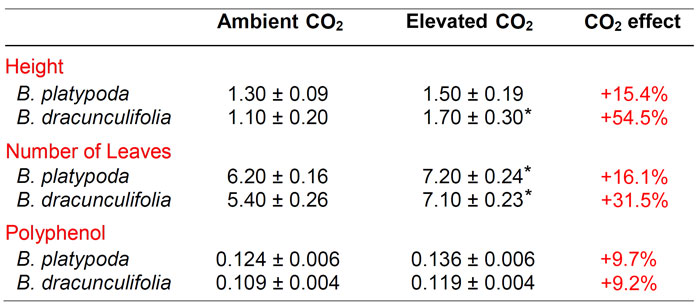| Tweet | Follow @co2science |
Paper Reviewed
Oki, Y., Arantes-Garcia, L., Costa, M.B.M., Nunes, B.C., Silveira, B.R., Gélvez-Zúñiga, I., Franco, A. and Fernandes, G.W. 2020. CO2 fertilizer effect on growth, polyphenols, and endophytes in two Baccharis species. Brazilian Archives of Biology and Technology 63: e20190302, dx.doi.org/10.1590/1678-4324-2020190302.
According to Oki et al. (2020), Baccharis dracunculifolia and Baccharis platypoda are two key shrub species in tropical South America of considerable economic and biological importance. In particular, the species thrive on soils contaminated with heavy metals, making them suitable for bioremediation. And high leaf concentrations of diterpenes, triterpenes and flavonoids enhance the usability of these two shrubs in a broad array of medical and cosmetic applications.
In light of the above attributes and uses, Oki et al. purposed to examine the effects of increasing CO2 on both Baccharis species. Their experiment was conducted in open-top chambers within an environment-controlled greenhouse at the Campus of the Federal University of Minas Gerais (Belo Horizonte, Minas Gerais, Brazil). There, seedlings were placed in pots in two treatments of either ambient (~390 ppm) or elevated (~775 ppm) CO2 levels. After 13 weeks the authors performed a series of measurements to determine differences in growth, leaf polyphenol concentration and endophytic fungi richness due to the different treatment conditions.
With respect to their findings Oki et al. note both Baccharis species "showed a positive effect on CO2 enriched conditions by increasing their growth on at least one of the quantified parameters (height and/or the number of leaves)." Indeed, as shown in Table 1 below, elevated CO2 stimulated plant height and leaf number by 15.4% and 16.1% in B. platypoda and 54.5% and 31.5% in B. dracunculifolia. With regard to plant secondary metabolism, the researchers report leaf polyphenol concentration "did not differ statistically between the CO2 enriched and ambient condition," albeit Table 1 reveals this parameter increased by approximately 9% in both species. Nevertheless, in response to the enhancement of plant biomass observed at elevated CO2 (i.e., the increase in leaf number), the overall polyphenol content increased. Lastly, Oki et al. note "endophytic fungi richness and their colonization rate did not vary in accordance with polyphenol concentration nor atmospheric CO2 concentration."
The results of this study bode well for the future of both Baccharis species. The enhanced growth under elevated CO2 signifies what the authors describe as "an important achievement, especially when considering the typically slow growth pattern of the Cerrado plant species." Ultimately, they envision such growth will bring about "a denser savanna." And because polyphenols are known to enhance plant physiological and performance, including the adaptability to environmental challenges such as light intensity, nutrient deficiency, extreme temperature and herbivory, the observed increase in both polyphenol concentration and content should also benefit the two shrub species. And these findings together suggests both Baccharis species will remain important for use in bioremediation and medical applications.





